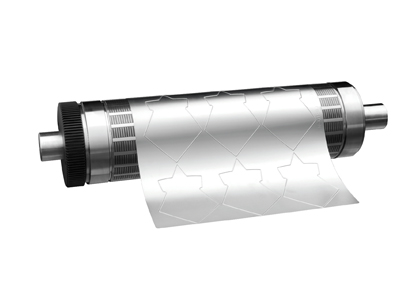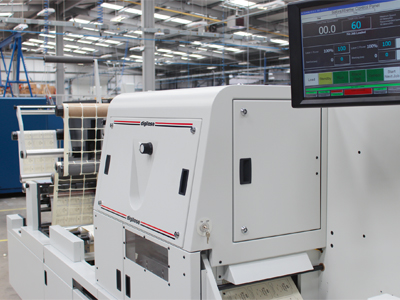The Digilase from AB Graphic
Increasingly intricate label shapes and thinner materials are demanding higher levels of sophistication from the die-cutting station, while shorter and shorter runs put pressure on the finishing process. By Neel Madsen.
Die-cutting labels can be done either inline through an integrated laser-cutting unit or by feeding straight into a converting line, sometimes via a buffer, or the process can be done on a near-line finishing system, which converts the printed reels of labels.
In conventional die-cutting of self-adhesive labels, rotary or semi-rotary systems will cut out the label shape using pressure to break the fibres of the substrate down to the release liner. For the converting of digitally printed webs, flexible dies mounted on a magnetic cylinder on semi-rotary systems are most common, whereas in very long runs in conventional printing, solid dies are also used.
Tooling
Die-cutting pressure need to be exact to ensure that the label will separate perfectly from the liner. The release liner in effect functions as an ‘anvil’ against which the die applies the correct amount of pressure to cut through the printed material.
Flexible dies are quick to produce and easy to ship, and can cut a wide variety of label types from simple rectangles to multi-layer booklets. These are steel sheets precision manufactured using CNC engraving technology made to extremely tight tolerances, with or without special coatings for a smooth surface and easy release. The edges of the engraving are finely milled to ensure accurate cutting performance; the exact specifications depend on the application.
RotoMetrics has the Accu-Series of flexible dies, defined by four distinct types that allow converters to choose the most appropriate for their specific requirements. They are: AccuSmart – the economical choice for most short and medium run lengths; AccuPrime – the choice for converting of a wider range of substrates; AccuStar Ultra-Film – challenging synthetics; and AccuStar Life – for converting abrasive materials.
Wink offers the SuperCut flexible dies which are produced with a special blade geometry and minimum height tolerances of ± 2 microns. As an option, the company’s ProShift technology can be used for staggered die-cutting. The staggering of labels in the web direction reduces the length of the simultaneously cutting transversal lines, so that the cutting pressure can be considerably reduced. This protects the liner material and increases overall efficiency.
For meeting the demands from ever thinner liners, Wink has introduced the GapControl adjustable anvil roller which has double-sided gap adjustment.
Kocher+Beck’s product line includes magnetic cylinders, print cylinders, anvils, hot stamps, pressure monitors, and the Gap Master, a precision adjustable anvil system with 0.8 microns adjustment.
Spanish manufacturer of flexible dies, Lartec, offers various types of treatment to extend the life of the die. The Enduro plasma treatment employs a titanium hardening process to increase the hardness and wear resistance by reducing the friction coefficient. The Anti-Tack treatment applies a non-stick coating to the surface of the flexible die to repel dirt, adhesive or ink residue. This allows improved speed and quality of waste removal, and reduces time spent cleaning the plates.

RotoMetrics has a range of flexible dies in the Accu-Series
Off line
Finishing systems with die-cutting are available from a number of suppliers, and some can be configured to include a whole host of other processes, including laminating, varnishing, foiling, flexo over-printing, holograms and braille to name a few.
AB Graphic International has the Digicon 3 modular finishing line which can be configured with semi-rotary die-cutting with automatic flexible die mounting and removing , or with its Digilase laser cutting module.
Yorkshire-based Daco Solutions has a range of die-cut to register machines for the converting of digitally printed webs. The DTD250R is table top machine for converting print from smaller systems, while the DCR Die Cut To Register totary die-cutter can be used with larger production systems, such as those from Xeikon and HP Indigo.
Focus Label Machinery has the Reflex range with full rotary servo drive technology and auto re-register system, allowing printed webs to be overprinted and finished to roll or sheet. Rotary die-cutting enables higher converting speeds than semi-rotary convertors and top speed is over 100 m/m.
Bar Graphic Machinery has the Elite FDTR (flexo die-cut and register) system for digital producers and also offers inkjet print modules to make a complete print and finishing line.
Grafotronic has a range of standalone die-cutting machines which are available is widths from 280 mm to 530 mm running at speeds up to 220 m/min. Options include servo motor for die-cutting of pre-printed webs in register, pressure control for flexible dies and GapMaster adjustable anvil cylinder from Kocher+Beck.
Minneapolis-based Delta Industrial provides a full range of finishing options on the Spectrum series, with semi-rotary die-cutting and laser cutting among the expandable modules.
Grafisk Maskinfabrik (GM) has both conventional and laser die-cutting machines. The DC330 laser hybrid system can be configured with unwind, web guide, flexo, lamination, laser-die, semi-rotary die, slit and rewind. It can also be delivered as a laser only converting unit. Meanwhile its DC500 offers 500 mm high-speed cutting in semi-rotary mode.
Spartanics E-Cut semi-rotary converting line can be fitted with semi-rotary die-cutting station, flexo varnish station, laminator, slitter/rewinder and has an option for a 200 Watt or 400 Watt Spartanics laser module. It runs at speeds up to 15 m/min.
In line
Some inkjet presses incorporates a laser cutting module where a high-powered laser vaporises the material with its beam. This is extracted at the point of cutting. Lasers eliminate the need for conventional tooling and the associated costs of production and storage. They are fully flexible, saving on set up time, turnaround and costs. In essence, each cut can be different, however, the more intricate the shapes the longer the cutting will take.
AB Graphic’s Digilase module is JDF compatible and can be integrated into an Omega converting line, digital label finishing line or any other rotary web fed machine. After cutting, the labels are matrix stripped and rewound in the conventional manner.
Colordyne’s CDT 1600-PC Laser Pro is a full colour digital printing system with high resolution printing and speed which features a high speed laser die-cutting system. It integrates LasX Industries V400 Laser System to kiss-cut, slit, or perforate label materials.
The EFI Jetrion 4950LX features a high-powered laser cutter – either a single 500 Watt or an optional dual-head 1000 Watt version for higher speeds at wider widths.
Spartanics has just introduced the X-350 laser cutting module, engineered to be integrated into Smag Graphique’s E-Cut and Digital Galaxie semi-rotary converting systems.
The X-350 is a modular laser station that can cut material up to 350 mm wide with an infinite length. It is capable of reaching cutting speeds of up to 100 m/m, comes standard with Spartanics’ Fastline and Optimisation Control software and is available in either a 200 watt laser or 400 watt laser. The modular solution can also be retrofitted.
‘The X-350 module provides label converters a more flexible finishing solution that is equipped with all of the features our existing customers have come to expect from a market leading laser supplier,’ said vice president of sales and marketing, Mike Bacon.
Spartanics’ technology can also be found on new Durst Tau 330 LFS finishing system, which is equipped with a 1000 Watt laser to run inline with the Durst Tau 330 inkjet press for automatic job and order changing in a single pass.
More standalone laser systems are also available from Delta Industrial, Cartes, LasX Industries, Sei Spa and GM.






